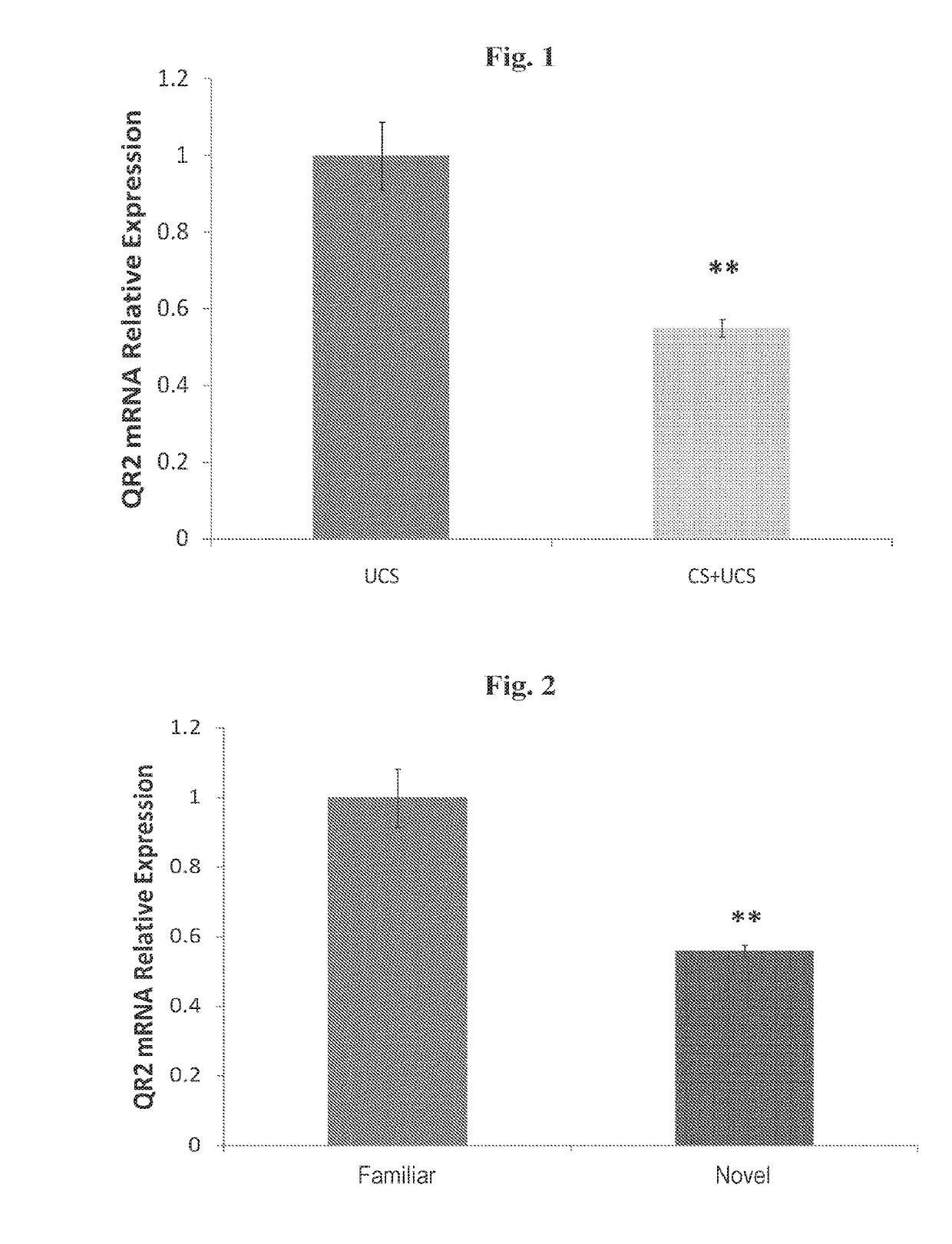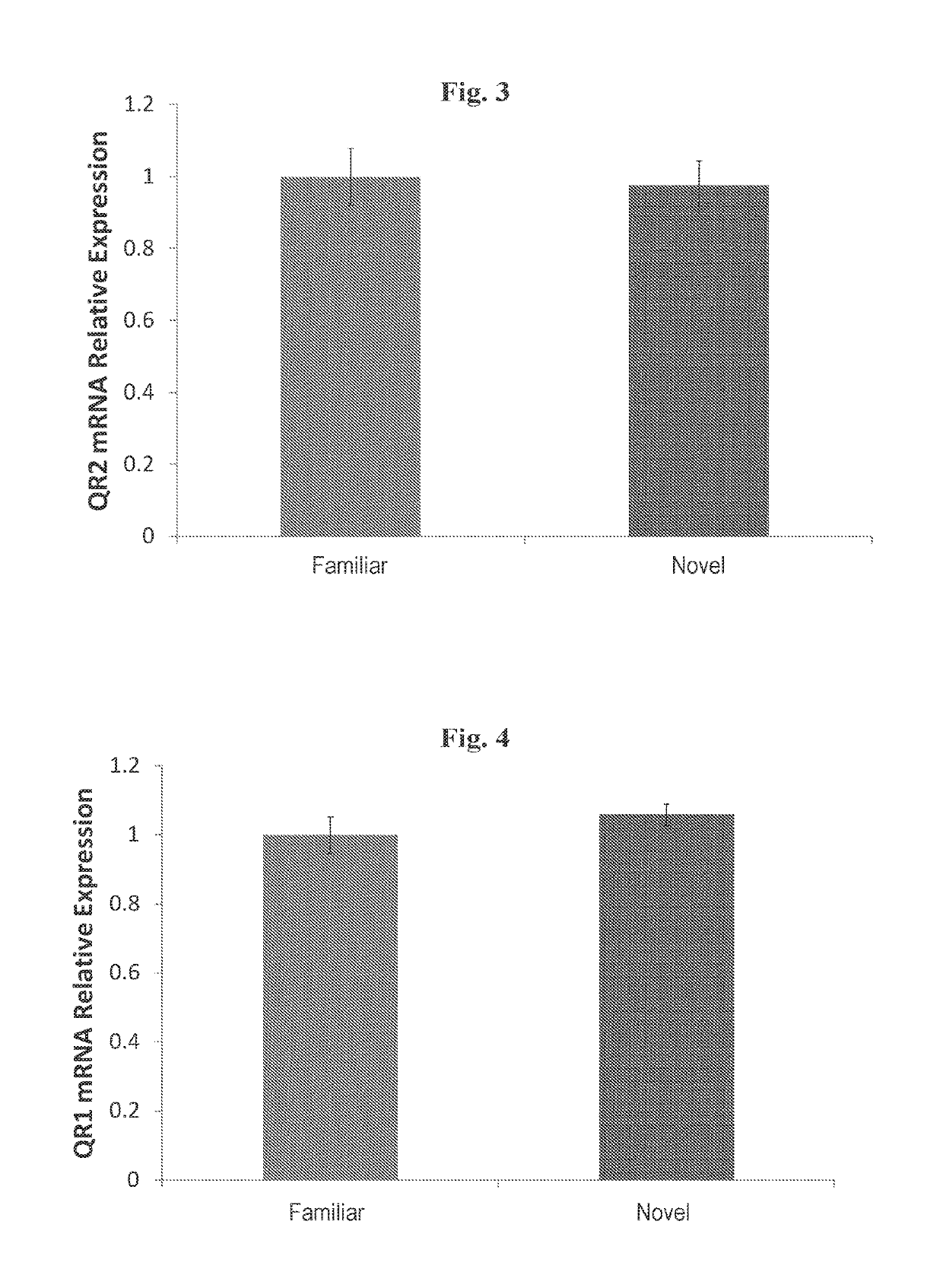Methods for improving cognitive function via modulation of quinone reductase 2
a technology of quinone reductase and cognitive function, applied in the field of improving cognitive function, can solve the problems of major health and social problems, decline in cognitive function, neurodegenerative diseases, etc., and achieve the effects of reducing the activity of quinone reductase 2, improving cognition, and improving cognition
- Summary
- Abstract
- Description
- Claims
- Application Information
AI Technical Summary
Benefits of technology
Problems solved by technology
Method used
Image
Examples
example 1
Novel Taste Learning Induces a Reduction in the Level of QR2 mRNA in the Insular Cortex
[0106]Rats underwent three days of water restriction, following which we gave the control group access to two pipettes containing 10 ml of water each for 20 minutes and the test group access to two pipettes containing 10 ml of 0.1% w / v saccharin for 20 minutes (novel taste) (the conditioned stimulus (CS)). Both groups were then injected with LiCl 0.15M (the unconditioned stimulus (UCS)) i.p. 40 minutes following the drinking period. There was no significant difference between the amounts consumed by each group (unpaired Student's t-test, t16.920=0.123, n=10, P>0.05). The animals were then sacrificed 4.5 hours later in order to evaluate changes in mRNA expression. RNA from the IC was extracted and used as a template to synthesize cDNA. We sent this cDNA to be evaluated using a microarray (Affymetrix® rat gene 1.1 St Array plate) to compare changes in gene expression in the group which learned to as...
example 2
Exposure to a Novel Taste Induces a Reduction in QR2 mRNA Expression in the IC
[0108]M&M—Two groups underwent three days of water restriction, following which we gave the control group access to two pipettes containing 10 ml of water each (a familiar taste) for 20 minutes and the test group access to two pipettes containing 10 ml of 0.1% w / v saccharin each (a novel taste) for 20 minutes. There was no significant difference between the amounts consumed by each group (unpaired Student's t-test, t20=0.509, n≥10, P>0.05). Both groups were sacrificed 3 hours following the drinking period in order to evaluate biochemical changes.
[0109]Results—To evaluate the hypothesis that the changes in QR2 mRNA expression in the IC following the associative taste learning seen in Examples 1 and were primarily due to the learning of a novel taste and not due to learning a taste association we isolated the variable factor from above. One group of animals learned a novel taste (saccharin) while the control...
example 3
The Changes in QR2 mRNA Expression Following Taste Learning are Specific to the IC
[0110]To verify that the changes in QR2 mRNA expression were indeed due to learning, and therefore were only present in the relevant brain region, the insular cortex, in which the gustatory area resides, we evaluated changes in QR2 mRNA expression in the same animals in a non-relevant brain region, the occipital cortex. We determined that there were no differences in QR2 mRNA expression in the occipital cortex (FIG. 3) supporting our hypothesis that the changes are induced by novel taste learning and therefore specific to the IC (unpaired Student's t-test, t13.89=0.144, n=8, p>0.05).
PUM
 Login to View More
Login to View More Abstract
Description
Claims
Application Information
 Login to View More
Login to View More - R&D
- Intellectual Property
- Life Sciences
- Materials
- Tech Scout
- Unparalleled Data Quality
- Higher Quality Content
- 60% Fewer Hallucinations
Browse by: Latest US Patents, China's latest patents, Technical Efficacy Thesaurus, Application Domain, Technology Topic, Popular Technical Reports.
© 2025 PatSnap. All rights reserved.Legal|Privacy policy|Modern Slavery Act Transparency Statement|Sitemap|About US| Contact US: help@patsnap.com



